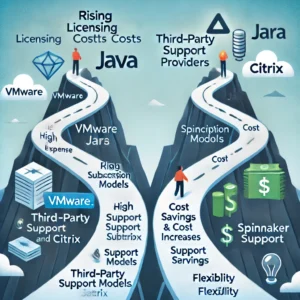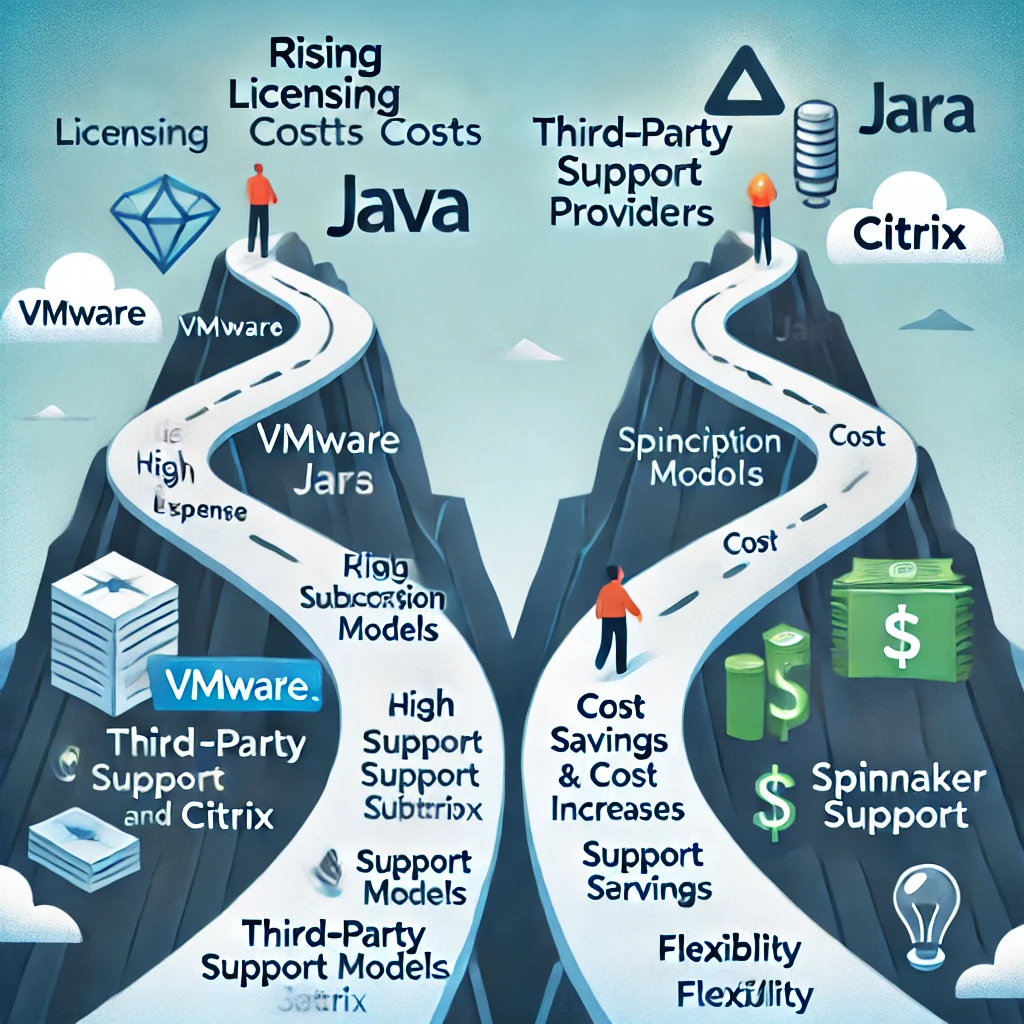In recent years, enterprise technology providers such as VMware, Java (Oracle), and Citrix have increased licensing costs, leaving many businesses searching for cost-effective alternatives. Companies are now exploring third-party support providers and alternative software solutions to manage their IT infrastructure without significantly impacting their budgets. In this blog, we’ll discuss why companies are turning to these alternatives, explore some leading third-party providers, and analyze the risks and benefits of transitioning away from traditional licensing models.
The Rising Costs of VMware, Java, and Citrix
VMware Licensing Changes
VMware, widely used for virtualization, has long been a staple in data centers. However, recent shifts in its licensing model, particularly with the introduction of subscription-based pricing and changes in core-based pricing structures, have dramatically increased costs for enterprises, especially those with large-scale operations. These new pricing strategies have left companies grappling with budget constraints while still needing robust virtualization solutions.
Java Licensing Fees
Oracle’s decision to introduce fees for Java SE subscriptions has also hit enterprises hard. What was once a free and open tool has now become a significant expense, with Oracle charging on a per-user or per-device basis. This shift has prompted many organizations to seek alternative Java distributions or third-party support providers that can offer continued service without the same steep price tag.
Citrix Licensing Hikes
Similarly, Citrix, a leader in desktop virtualization and remote access solutions, has increased its licensing fees and is steering customers toward its cloud services, which may not align with all business needs. The higher costs, combined with a move toward cloud-centric solutions, have left businesses looking for more flexible and affordable alternatives.
Third-Party Support Providers and Alternatives
As a result of these increasing licensing costs, companies are increasingly turning to third-party support providers or open-source alternatives to manage their IT needs. Here are a few third-party providers offering competitive services:
1. Rimini Street
- Services Offered: Rimini Street provides third-party support for a wide range of enterprise software, including VMware, Oracle, SAP, and more.
- Benefits: Rimini Street is known for reducing annual maintenance costs by up to 90% compared to vendor support. They also extend the lifecycle of legacy software, allowing companies to maintain existing systems longer without being forced into costly upgrades or migrations.
- Comparison: Compared to VMware’s or Oracle’s own support, Rimini Street offers more flexible contract terms, personalized customer service, and guaranteed 24/7 support with dedicated engineers. In contrast, vendor-provided support often includes mandatory updates and more rigid structures that don’t suit every business.
2. Spinnaker Support
- Services Offered: Spinnaker Support provides third-party support for Oracle, SAP, and Salesforce, as well as enterprise Java solutions.
- Benefits: Spinnaker Support offers significant cost savings and a more tailored approach to software support. For example, their Java support services allow businesses to continue using Java without Oracle’s licensing fees, offering customized patches and security updates.
- Comparison: Unlike Oracle’s Java subscription, which requires ongoing payments based on the number of users or devices, Spinnaker Support’s model provides fixed pricing with fewer restrictions. This flexibility is particularly appealing to companies managing large Java installations.
Benefits of Moving to a Third-Party Provider
1. Cost Savings
The most significant advantage of choosing a third-party support provider is the potential for substantial cost savings. Many businesses report cutting software maintenance costs by 50-90%, freeing up resources for other critical initiatives.
2. Extended Software Lifecycle
Third-party providers often offer support for legacy systems that vendors no longer service. This allows businesses to continue using their existing infrastructure without being forced into expensive upgrades or migrations, extending the value of their investments.
3. Flexibility and Customization
Many third-party providers offer more flexible support plans that are tailored to the specific needs of an organization. This contrasts with the “one-size-fits-all” approach of traditional vendors, where support is tied to rigid contracts and schedules for software updates.
4. Improved Customer Service
Third-party support providers are often praised for their personalized service and dedicated engineers, which can be a marked improvement over vendor support systems that rely on tiered service levels and often require long wait times for critical fixes.
Risks of Moving to a Third-Party Provider
While the benefits are appealing, moving to a third-party support provider or an alternative solution comes with certain risks. Businesses should carefully weigh these factors before making a switch.
1. Loss of Vendor Support
One of the most notable risks is that companies will no longer receive direct support or patches from the original software vendor. This can become problematic if the vendor releases important updates or security fixes that third-party providers are unable to replicate.
2. Potential Compatibility Issues
With third-party providers managing patches and updates, there’s a possibility of incompatibility with newer technologies or software versions. Companies may find that certain features do not work as intended without the direct involvement of the original vendor.
3. Vendor-Locked Features
Some features may be vendor-locked, meaning that only the original provider can offer access to proprietary functionalities or software tools. If a business relies heavily on these features, third-party support may not provide a complete solution.
Considerations When Making the Switch
When deciding whether to switch to a third-party provider, companies should evaluate their software needs, budget constraints, and risk tolerance. Key considerations include:
- Software Criticality: If the software is mission-critical, businesses may be more hesitant to leave vendor support, despite the cost.
- Long-Term Plans: For companies planning to migrate to a different solution in the future, third-party support may serve as a cost-effective stopgap measure.
- Legal and Compliance Issues: Moving away from vendor support could have implications for software licensing agreements or regulatory compliance. Legal teams should be consulted before making any transitions.

The rising costs of VMware, Java, and Citrix have prompted many companies to explore third-party support providers and other alternatives. Providers like Rimini Street and Spinnaker Support offer competitive services, often at a fraction of the cost. While the switch can result in significant cost savings and operational flexibility, businesses should carefully consider the risks, including loss of vendor support and potential compatibility issues. Ultimately, the decision to move to a third-party provider should align with the company’s long-term IT strategy and budgetary goals.

